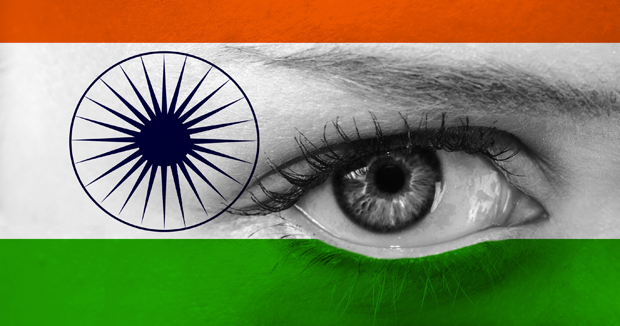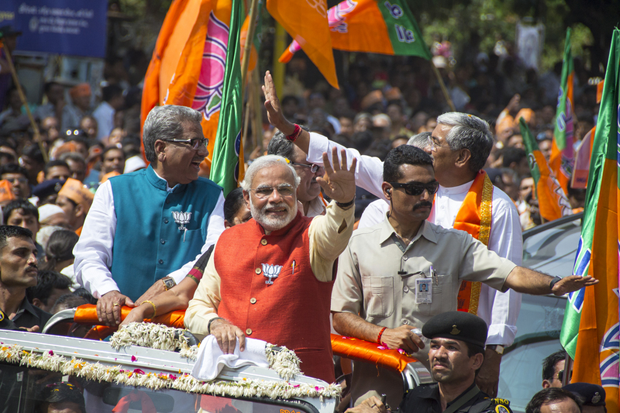28 Apr 2014 | India, News and features, Politics and Society, Religion and Culture

(Photo illustration: Shutterstock)
The cauldron has always been simmering, despite abundant shibboleths about this election not being about hate or Hindutva (the communal political ideology of the Hindu Right wing) but about development.
Therefore it came as no surprise when on 19 April, the Vishwa Hindu Parishad’s (VHP) International President Praveen Togadia exhorted a mob in Bhavnagar to storm a house which had recently been purchased by a Muslim businessman. And in case he refused to vacate the house within 48 hours, Togadia raged, go after him with stones and tyres. After all, since those who went on the rampage in the 1984 Delhi riots have enjoyed impunity, there’s nothing to fear, he thundered. Ram Madhav, a senior functionary of the RSS (Rashtriya Swayamsevak Sangh), stoutly defended Togadia. But the Bharatiya Janata Party (BJP) and its prime ministerial candidate Narendra Modi have remain tight-lipped about the entire affair.
It is unfortunate, alarming, but true that hate propaganda has always yielded rich political dividends, and the BJP and its allies of the Hindu right have been frontrunners in making the most of it. If that wasn’t bad enough, the Election Commission, the supreme authority in charge of managing and conducting polls, has been woefully inept at dealing with this malaise. Consider this, Amit Shah, Modi’s henchman and campaign manager, got away with a mere censure after egging on people in riot-torn Muzaffarnagar to vote for the BJP if they wanted revenge on Muslims.
The fault doesn’t lie with the Election Commission, though. It is the lacunae in the laws which allow the purveyors of hate and bigotry to have a free hand. India’s election law prescribes a “Model Code of Conduct” which prohibits incendiary speeches, especially those pandering to religion and seeking to stir up communal violence. But mere prohibition, without adequate authority for imposing meaningful punishment which acts as a deterrent, is not of much use. And it is here where the commission’s hands are tied. The code does not have any legal teeth, so a candidate caught delivering hate speeches cannot be debarred. For instance, in 2009, Modi had a crowd baying for the blood of Muslims, but the commission’s chief stated that he couldn’t do much except “rebuke”.
The cynical subterfuge adopted by political parties aggravates the situation. Immediate legal action is ruled out, since the law permits a candidate’s election to be challenged only after the results are declared, thereby giving ample opportunity to the poisonous tree of hate to bear its bitter fruit. In the meanwhile, the offenders parrot vehement denials, knowing very well that dilatory tactics only work in their favour. Modi did it 2002, engaging in protracted sparring with the Indian Supreme Court, and in 2007, the BJP’s rebuttal of charges of having widely disseminated a CD containing communally inflammatory speeches fell apart only when a sting operation by an investigative journalism magazine exposed all the lies.
More insidious than explicitly incendiary speeches is what can be termed as religious electioneering, that is, canvassing for votes in the name of religion. It’s a tried and tested strategy of the BJP and its allies, particularly militant Hindu organisations like the RSS and VHP. This is usually done by glorifying Hinduism and pandering to a manufactured sense of victimhood, which, in the political arena, inevitably morphs into vilification of “the other”, “the minorities” — Muslims and Christians, primarily the former. In BJP-ruled Madhya Pradesh in central India, the RSS distributed pamphlets urging Hindus to vote in full strength in order to put the minorities in their place. The supreme court is primarily to blame for this state of affairs, because in a 1996 decision, it erroneously conflated Hinduism with the communal political ideology of Hindutva and acquitted a demagogue notorious for his Islamophobic screed.
It would be a mistake to believe that hate speech is the sole preserve of the militant Hindu Right. Azam Khan, representing the Samajwadi Party, remains defiant about his tirade, while Akbaruddin Owaisi, experienced in the politics of hate, remains unscathed due to the patronage and skulduggery of the Congress.
The Togadia saga isn’t over yet. Going by standard modus operandi, not only has he has alleged a political conspiracy to frame him, but has also slapped a legal notice on the television channels and newspaper which reported his Saturday’s labours. Senior journalists from these channels, however, are standing their ground, contending they have video footage to prove his culpability.
Optimistic about better politics? Look at 21 April, Mumbai. With Modi on the dais, a political ally boasts that he would be the best one to teach Muslims a lesson. And the man being hailed as the next prime minister “disapproves” of “petty statements” by the likes of Togadia.
This article was originally posted on 28 April 2014 at indexoncensorship.org
24 Apr 2014 | India, News and features, Politics and Society, Religion and Culture

“Gas Wars — Crony Capitalism and the Ambanis” is journalists Paranjay Guha Thakurta, Subir Ghosh and Jyotirmoy Chaudhuri’s collaborative effort exposing one of India’s biggest business conglomerates’ murky dealings with the government.
The authors detail how a hydrocarbon production sharing contract in Krishna Godavari, off the Bay of Bengal, in Andhra Pradesh, was allegedly rigged to benefit Reliance Industries Limited (RIL) headed by Mukesh Ambani, at significant cost to the public exchequer. The book contends that high ranking government officials, including ministers, aided and abetted the pillage of public resources.
A fire-and-brimstone attorney’s notice from RIL arrived the day after the book was launched. It had quite an eerie feel to it. The notice started with a disclaimer about the Reliance groups’ highest regards for constitutional rights including freedom of expression, and then accused the authors of a deep-rooted conspiracy to malign the company’s reputation. It took strong exception to the book’s title and went on to allege that the contents are nothing but malicious canards. Nothing sort of an unconditional public apology would mitigate the harm caused, failing which, criminal and civil proceedings would be unleashed. Drawing lessons from the Wendy Doniger episode, the notice threw out a wide net. It included not only Authors Upfront and FEEl Books Private Ltd, the e-book publisher and distributors, but also “electronic distributors” like Flipkart and Amazon.in. Even the Foundation for Media Professionals, a non-governmental organisation which forwarded e-invites for the launch event, was not spared. A second notice in the same vein, this time from RNRL, followed soon after.
Why does the book roil the Ambanis? In an interview, Guha Thakurta, one of the authors, revealed that the book delves into how both the central and the Gujarat governments worked hand-in-glove with the Reliance companies in structuring the deal. In effect, the government kowtowed to the companies’ diktats, the authors assert. It went out on a limb to hike the price of gas, and was stopped in its tracks by the Election Commission.
Moreover, it has become a hot-button political issue since the Aam Aadmi Party, which is contesting the elections on an anti-corruption plank, has left no stone unturned to relentlessly question the Ambanis and Gujarat chief minister Narendra Modi, who is running for prime minister. The questions have so unsettled the Reliance companies that they have taken to an “Izzat (honour) campaign” and SMS blitz to convince Indians of its innocence. Further, the companies claim in court that they are victims of a “honey trap”- apparently the government isn’t the custodian of the country’s natural resources and had lured them with false promises.
Guha Thakurta maintains that he has acted in the finest traditions of fairness and journalistic integrity. Senior officials of the companies have been interviewed, their views, refutations and assertions–everything has been presented. But his travails in publishing the book provide cause for consternation. Self-publication was the sole option, if one goes by Bloomsbury India‘s craven surrender. For the record, not only did it withdraw a book which would have exposed how India’s national airline was bled dry, but went ahead and apologised to the minister who threatened to sue for libel. A leading national publisher had been approached, and a deal had been worked out, but Guha Thakurta decided to go solo when substantial changes were demanded.
For Reliance, intimidating anyone who isn’t writing hagiographies of Dhirubhai Ambani–the company’s founder–is par for the course; one is a worse offender for even whispering anything against their cavorting with officials in the top echelons of government. And their modus operandi of silencing criticism reveals the extent of crony capitalism.
In its May 2013 issue, Caravan magazine published a cover story on India’s Attorney General. It bared details about how his opinions to the government were tailored to help the Ambanis wiggle out of an investigation into a graft scandal. Interestingly, three legal notices, each more threatening than the other, reached the magazine in the month of April, demanding complete silence. Caravan took them head on, but not every publisher would have the wherewithal to resist impending SLAPP suits.
The threats to Caravan were benign if compared with what the Ambanis did to “The Polyester Prince”, Hamish McDonald’s 1998 biography of Dhirubhai. The plight of that book is a true testament to the Ambanis’ power of insidious censorship. Incessant threats of injunctions from every high court in India ensured that the book quietly vanished off the shelves.
And why not? McDonald had quoted him — “I don’t break laws, I make laws.”
UPDATE:
If there were any doubts as to the extent of Reliance Industries’ determination to suppress the tiniest whisper of criticism, they are dispelled by the latest fusillade hurled against the authors. This comes in the form of a couple of fresh legal notices laden with preposterous claims and egregious threats.
The first one, dated 22 April, cherrypicks random, disjointed passages from the book to make out a case for libel. Suffice it to say, even prima facie innocuous statements have been included.
Dated 23 April, the second one accuses the authors of malevolent mendacity in publishing and publicising their “pamphlet” (yes, that’s the term used to substantiate the charges of the book being a piece of malicious propaganda), and goes on to claim that even the launch event was designed to malign the companies.
At that event, Guha Thakurta had quoted former Governor of West Bengal Gopalkrishna Gandhi’s statement that “Reliance was a parallel state, brazenly exercising total control over the country’s resources”. But Reliance hasn’t trained its guns on Gandhi; instead it accuses the author of slander. It is not pusillanimity but very sound legal strategy — the modus operandi of SLAPP suits, which the company adopts because taking on Gandhi, a widely respected and renowned public figure, would backfire.
Playing both judge and jury, Reliance determines that a sum of INR 100 crore (10 billion) as “token damages”, to be paid within ten days, would be just restitution. Never before has any plaintiff arrogated to itself such a right even before going to court.
The next claim is much more sinister. The authors are directed to remove all traces of “publicity material” — both in print and on the internet, including the website http://www.gaswars.in/. This patently means that even this particular report has to be taken off. Since when have two corporations been so imperious as to stake claim to sovereignty over the internet?
An earlier version of this article identified the basin in question in the production sharing contract as one Kasturba Gandhi in Gujarat, when it should be Krishna Godavari, off the Bay of Bengal, in Andhra Pradesh. An earlier version also stated that both Reliance Industries Limited (RIL) headed by Mukesh Ambani, and Reliance Natural Resources Limited (RNRL) headed by Anil Ambani, were involved in the sharing contract, when it should only be RIL. This has been corrected.
This article was originally posted on 24 April 2014 at indexoncensorship.org
22 Apr 2014 | India, News and features, Politics and Society

Gujarat Chief Minister and BJP prime ministerial candidate Narendra Modi filed his nomination papers from Vadodara Lok Sabha seat amid tight security on April 6. (Photo: Nisarg Lakhmani / Demotix)
Electioneering for the Indian elections of 2014 has reached a fever pitch. Never before in the history of modern India has it seemed likely that the country is ready to cut its cord with the Congress Party’s Gandhi family, and never before has its chief opposition party, the Bharatiya Janta Party (BJP) been projected as the sole inheritance of one man – Narendra Modi.
The “greatest show on Earth” – the Indian elections – is underway. There are 37 days of polling across 9 states, with a 814 million strong electorate, and more than 500 political parties to choose from. The hoardings all seem to scream the “development” agenda, but unfortunately in India, this conversation seems to be skating on thin ice. Cracks quickly appear, and beneath the surface, political parties seem to be indulging in the same hate speech, communal politicking and calculations that work to polarise the electorate and garner votes.
Hate speech in India is monitored by a number of laws in India. These are under the Indian Penal Code (Sections 153[A], Section 153[B], Section 295, Section 295A, Section 298, Section 505[1], Section 505 [2]), the Code of Criminal Procedure (Section 95) and Representation of the People Act (Section 123[A], Section 123[B]). The Constitution of India itself guarantees freedom of expression, but with reasonable restricts. At the same time, in response to a Public Interest Litigation by an NGO looking to curtail hate speech in India, the Court ruled that it cannot “curtail fundamental rights of people. It is a precious rights guaranteed by Constitution… We are 128 million people and there would be 128 million views.” Reflecting this thought further, a recent ruling by the Supreme Court of India, the bench declared that the “lack of prosecution for hate speeches was not because the existing laws did not possess sufficient provisions; instead, it was due to lack of enforcement.” In fact, the Supreme Court of India has directed the Law Commission to look into the matter of hate speech — often with communal undertones — made by political parties in India. The court is looking for guidelines to prevent provocative statements.
Unenviably, it is the job of India’s Election Commission to ensure that during the elections, the campaigning adheres to a strict Model Code of Conduct. Unsurprisingly, the first point in the EC’s rules (Model Code of Conduct) is: “No party or candidate shall include in any activity which may aggravate existing differences or create mutual hatred or cause tension between different castes and communities, religious or linguistic.” The third point states that “There shall be no appeal to caste or communal feelings for securing votes. Mosques, churches, temples or other places of worship shall not be used as forum for election propaganda.”
This election season, the EC has armed itself to take on the menace of hate speeches. It has directed all its state chief electoral officers to closely monitor campaigns on a daily basis that include video recording of all campaigns. Only with factual evidence in hand can any official file a First Information Report (FIR), and a copy of the Model Code of Conduct is given along with all written permissions to hold rallies and public meetings.
As a result, many leaders have been censured by the EC for their alleged hate speeches during the campaign. The BJP’s Amit Shah was briefly banned by the EC for his campaign speech in the riot affected state of Uttar Pradesh, that, Shah had said that the general election, especially in western UP, “is one of honour, it is an opportunity to take revenge and to teach a lesson to people who have committed injustice”. He has apologized for his comments. Azam Khan, a leader from the Samajwadi Party, was banned from public rallies by the EC after he insinuated in a campaign speech that the 1999 Kargil War with Pakistan had been won by India on account of Muslim soldiers in the Army. The EC called both these speeches, “highly provocative (speeches) which have the impact of aggravating existing differences or create mutual hatred between different communities.”
Other politicians have jumped on the bandwagon as well. Most recently, the Vishwa Hindu Parishad’s Praveen Togadia has been reported as making a speech targeting Muslims who have bought properties in Hindu neighborhoods. “If he does not relent, go with stones, tyres and tomatoes to his office. There is nothing wrong in it… I have done it in the past and Muslims have lost both property and money,” he has said. There was the case of Imran Masood of the Congress who threatened to “chop into pieces” BJP Prime Ministerial candidate Narendra Modi – a remark that forced Congress’s senior leader Rahul Gandhi to cancel his rally in the same area following the controversy that erupted. Then there is Modi-supporter Giriraj Singh who has said that “people opposed to Modi will be driven out of India and they should go to Pakistan.” In South India, Telangana Rashtra Samithi (TRS) president K Chandrasekhar Rao termed both TDP and YSR Congress (YSRCP) as ‘Andhra parties’ and urged the people of Telangana to shunt them out of the region. The Election Commission has directed district officials to present the video footage of his speeches at public meetings, in order to determine punishment, if needed. Karnataka Chief Minister Siddaramaiah has been served notice by the EC for calling Narendra Modi a “mass murderer”; a reference to his alleged role in the Gujarat riots of 2002.
Shekhar Gupta, editor of the national paper, the Indian Express has published a piece ominously titled “Secularism is Dead,” but instead appeals to the reader to have faith in Indian democracy far beyond what some petty communal politicians might allow. The fact that the BJP’s Prime Ministerial candidate is inextricability linked in public consciousness to communal riots in his home state of Gujarat has only compounded speeches over and above what people believe is the communal politics of the BJP that stands for the Hindu majority of India. In contrast, many believe that by playing to minority politics, the Congress indulges in a different kind of communal politics. And then there are countless regional parties, creating constituencies along various caste and regional fissures.
However, perhaps the last word can be given to commentator Pratap Bhanu Mehta who writes of the Indian election: “But what is it about the structures of our thinking about communalism that 60 years after Independence, we seem to be revisiting the same questions over and over again? Is there some deeper phenomenon that the BJP-Congress system seems two sides of the same coin to so many, even on this issue? The point is not about the political equivalence of two political parties. People will make up their own minds. But is there something about the way we have conceptualised the problem of majority and minority, trapped in compulsory identities, that makes communalism the inevitable result?”
It is this inevitability of communal diatribe, of the lowest common denominators in politics that Indian politics need to rise above. This is being done, one comment at a time, as long as the Election Commission is watching. The bigger challenge lies beyond the results of 16 May, 2014.
This article was posted on 22 April 2014 at indexoncensorship.org
22 Apr 2014 | India, News and features, Politics and Society

In 2013, by way of abundant caution, Harper Collins India decided to pixellate a total of nine panels, including all the close-ups of penises in David Brown’s graphic novel “Paying for It.” While the content, in which Brown narrated his encounters with sex-workers, was left untouched, the publishers were wary of India’s laws against obscenity which make the depiction of nudity almost verboten. This is because a sheet of prudery covers any sexual expression and also governs the legal regulation of sexual speech.
Hence, many welcomed the Indian Supreme Court’s February 2014 ruling that merely because a picture showed nudity, it wouldn’t be caught within the obscenity net- “a picture can be deemed obscene only if it is lascivious, appeals to prurient interests and tends to deprave and corrupt those likely to read, see or hear it,” and having a redeeming social value would save it from being censored.
The decision came in an appeal filed in 1993. Sports World, a magazine published from Calcutta, had reproduced the photo on the cover of German magazine Stern. In that photograph, Boris Becker had posed nude with his then fiancée Barbara Feltus; it was his way of protesting against the racist abuse the couple were being subjected to. A solicitous lawyer dragged Sports World to court, alleging that the morals of society and young, impressionable minds were in jeopardy. He cited Section 292 of the Indian Penal Code which prohibits and penalises any form of expression tending towards prurience and encouraging depravity in the readers or viewers. The court rejected the contention, holding that the Hicklin’s Test for determining obscenity has become obsolete, besides imposing unreasonable fetters on the freedom of expression. This test, formulated by the House of Lords in 1868 in Regina v. Hicklin stipulated that ‘‘The test of obscenity is whether the tendency of the matter charged as obscenity is to deprave and corrupt those whose minds are open to such immoral influences and into whose hands a publication of this sort may fall.’’
Instead, the United States Supreme Court’s ruling in Roth – wherein “contemporary community standards” were held to be a far more reasonable arbiter, was directed to be adopted. The court also affirmatively cited the decision in Butler which, while upholding the test in Roth, added that anything which showed undue exploitation of sex or degrading treatment of women would remain prohibited.
While the Hicklin’s Test being jettisoned is a cause of relief, the judgement by no means can be held as finally freeing Indian law from the shackles of “comstockery.” George Bernard Shaw had coined this term in 1905 while raging against Anthony Comstock who had taken it upon himself to rid American society of vice. For Comstock, lust and sexual desire were abhorrent, and as he candidly proclaimed anything which even remotely arouses any sexual desire was to be dealt with in the most stringent manner. No wonder he had called Shaw an “Irish smut-peddler” in retaliation.
Gymnophobia, or the fear of nudity, isn’t something new to India’s Supreme Court. Also, it has always been female nudity and the fear of sexual desire which have governed the Court’s opinions. Its image-blaming position has repeatedly been used to reinforce the assumption that sexually explicit images trigger urges in men for which they cannot be held responsible. Depictions of nudity WERE condoned only if they achieved some “laudable social purpose” such as encouraging family planning or making people aware of caste-based atrocities. As Martha Nussbaum points out, collapsing the “disgust” for the nude female body with male sexual arousal and regarding sex as something furtive and impure results in the revulsion being projected on to the female body, thereby making the legal definition of obscenity collude with misogyny.
The present decision is no different. Because Feltus’ breasts were covered by Becker’s arm, and also because Feltus’ father was the photographer, it was held that only the most depraved mind would be aroused and titillated by the magazine cover. Most troubling of all is the overt reliance on contemporary community standards. True, that Indian society has evolved since 1993, but as Brenda Cossman details the scene in Canada in Butler’s aftermath, community standards became a rubric for majoritarian sexual hegemony, resulting in persecution and censorship by prudish vigilantes. And of course, it goes without saying that the search for “redeeming social value” usually ends at puritans’ doorsteps.
Comstockery’s tattered banner, emblazoned with “Morals, not art!” flies aflutter in India.
This article was posted on 22 April 2014 at indexoncensorship.org




